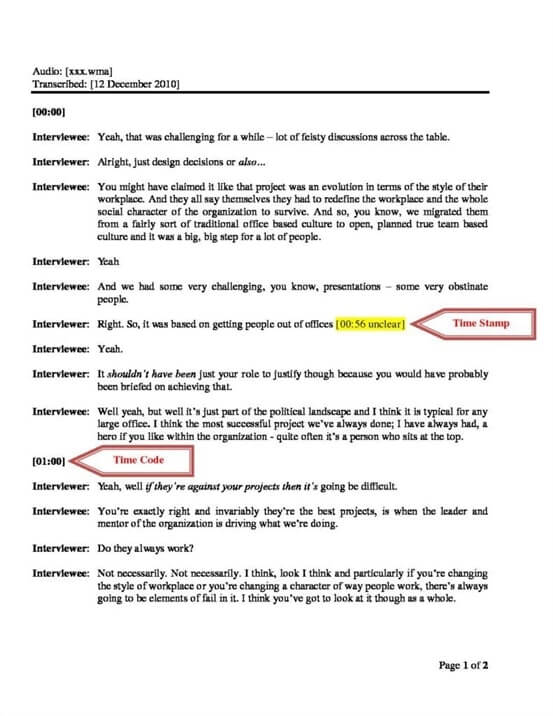
Transcription is the easiest way to convert audio files into script or text formats. This is a process that has been existence for a very long time. Most times people used to refer to it as just typing out audio dialogues into a word document or writing them on a piece of paper. The professionals who do transcriptions are known as transcribers or transcriptionists.
With that said, in this article, we will be looking at how to transcribe interviews. It might sound like a hard and tiresome process but you will be surprised at how easy and straight to the point it is:
What Methods Can You Choose When Transcribing An Interview?
Depending on how important your files are, it is advisable to use human transcribers, who will always guarantee you accuracy on your transcribed scripts. Human transcribers can research and get correct information on an audio track that is inaudible or distorted. Machine-generated transcripts are not dependable because they are not as keen and accurate as a human transcriber would be.
The choice on how to transcribe an interview will depend on the number of speakers, the content of the recording, different accents used, and the tempo of the speech. There are two ways in which transcribing interviews can be done which will be discussed below:
1. Automatic transcription
The automatic transcription of interviews refers to the use of transcription software that assists the transcriber in converting the audio of the interview into a written text. The development of new software makes this a faster option than manual transcription but mistakes still occur in the transcript from audio or video to text. The advantage is that the user has a software-generated text available that can be reviewed, revised, edited, and proofread to produce a near-perfect text in much less time. The advantage is that a text copy uses much less memory than an audio recording and can be printed out as a document.
2. Manual transcription
Manual transcription can be done by you; another option is to outsource it to a professional transcriber. Manual transcription refers to the process where the transcriber sits down and listens to the voice recording of the interview, preferably while using headphones.
The transcriber then turns the audio recording into a written text in accordance with the brief provided or as required by the research project. The transcript can be done as a verbatim transcript, intelligent verbatim transcript, or as an edited version of the intelligent verbatim transcript.
An hour-long interview may take 6 to 7 hours, depending on your typing skill.
Steps To Transcribing An Interview Manually
- Playback the recorded audio- Before you decide to transcribe any given audio, be it a speech or an interview or anything, as long as it is a form of audio you should always play it back. The reason why it is advisable to playback audio is so that you can familiarize yourself with it and pinpoint what kind of audio it is. If it is an interview, you can easily pinpoint that it has two or more speakers, you can further go ahead and determine whether the speakers are female or male which will help you in tagging them. Playing it back will also help you in finding out what industry the audio revolves around. You should never start transcribing audio with playing it back, it is very easy to have things mixed up when you jump into something without first ensuring what it entails.
- Take note of time codes- Depending on what kind of transcriber you are, it is important to take time codes of the different dialogues in your audio. If you are an amateur transcriber the simplest way to take these time codes is to record them manually on another document. If you are a professional transcriber then you will be aware that there is software that can help you in taking note of the time codes and creating them easily on there. The time codes are simply to help you know when a speaker starts their dialogue and where the dialogue stops. You should be very keen on this particular point because it will make your transcription process really easy and efficient.
- Label the speakers when they speak: Be sure to record the different speakers on your dialogue as they speak. Given it is interview audio, you should be able to note which speaker is the interviewer and which speaker is the interviewee. What this does is that it will give an idea of who was speaking at what time and who was not. Who was asking the questions on the dialogue and who was answering the questions? In a scenario where it is a discussion kind of interview, more times than not it will not be clear on who is the interviewer and who is the interviewee, and as the transcriber you should make it possible for someone to differentiate.
- Listen to the words being said: You should be very keen on listening to the words being spoken on the audio you are working on. More times than not, you will find a script that is completely off from the original film. This only means that the transcription was not a success because the transcriber was not accurate with their words. The only reason it is important to keenly listen to the words being said is that it Is very easy to hear one thing that is totally opposite of what is being said. Accuracy is the most important thing in transcription and if you are not accurate with the script then automatically the transcription is a mess.
- Type the words said by each speaker: Since you are working on interview audio, you should always type out words that are spoken by each speaker. You cannot decide to simply type out words said by one speaker who might be the interviewer or interviewee and ignore the other speaker. If you do that then the script will be inconclusive. Transcribing audio means that you are supposed to type out every possible utterance on the audio even the filler words. Unless a client gives rules on how they want their audios transcribed, be sure to type out all the words being spoken by a speaker.
- Revise and re-listen to the audio: After you are done writing out all the words on your audio while including the filler words, it is now time to revise your script while listening to the audio. This is some sort of proofreading where you read through your script as you listen in on the audio to see if there are any words or sentences you have missed. This is actually the best way to proofread your scripts because you will be comparing your words and the words on the audio. You can do this process for as many times as you want until you are content with your scripts.
- Correct spelling and grammar: After revising your script and re-listening to your audio and concluded that both the script and audio go hand in hand, you can go ahead and make the possible spelling and grammar errors. This is also dependent on what your client wants. If your client doesn’t want you to clean up the grammar, and they happen to want the scripts with all the grammatical errors on the audio, that is exactly what you should do. On the other hand, if your client needs you to clean up the grammatical and spelling errors than you should make sure to do that on this step. Make sure that all the sentences make sense grammatically and that the words are correctly spelled.
- Break up large paragraphs of text: When you are done with akin corrections on the grammatical and spelling errors, you should go ahead and break any long paragraph texts. There are people who usually speak and you can’t really tell where sentences break or end and it is easy to have really long sentences when you transcribe such kinds of audios. This is why you should make sure to break long paragraphs and put correct punctuation where possible. This means that you must be someone who understands the punctuation rules of the language you are working with so that you avoid messing up your script. Large paragraphs can make a script look off and that is why if you can you should break them.
- Format your document: Depending on what format you are working with or the format that your client wants the scripts in, you should always format your documents accordingly. If you are using software for your transcription process, the documents will automatically take the format of that software. If you were typing directly on a Word document then automatically your script format will be a word document. This is the point is really not as important but from time to time you might find clients who loves their scripts being in certain formats and you should be able to provide that for them.
- Don’t forget to save: This is a step that should be included in every step along the way as you start the transcribing process. It is very important to save every change you make and every time you add information on your document when typing out your audio. This will ensure that your script is intact if anything was to happen like the machine switching off or a power blackout. It is also important to save your document at the end of the whole process to ensure that all the changes have been permanently saved. The corrections for the grammar and spelling errors should be saved too. This is the last step of the whole process. When you press that last save button, it means that you are content with how the scripts turned out and you can present them to your client.
Quick Tips For Faster Manual Transcription
- Write the name of the interviewer, interviewee, time, date, and location, where it took place.
- Interviews are in a question-and-answer format.
- Use a foot pedal to stop and start your tape. Play a small section at a time and type as you hear them. Repeat the tape as and when required. Include both questions and interviewee’s answers.
- Transcribe every word. Sometimes some words are not very clear, there you read the whole paragraph and make an intelligent guess. Put that into a bracket to show that it is your text, not from the original sources.
- Insert a paragraph in between whenever an interviewee makes a new idea. Put a space in between each speaker. If needed, you can edit into more paragraph in the last copy.
- After finishing the initial draft, listen to the tape again. Read the transcribed interview at the same time. Do corrections.
- Now start editing. Spell out abbreviations and clear all punctuations.
- Correct grammar and the content in the last copy.
- Excessive use of verbal tics like “I mean”, “you know” etc. You can also edit ‘um’, ‘uh’ like fillers, which is a distraction while delivering a message of the total interview.
- Save each stage of your typed interview in a separate file for further reference.
- Check the spellings for the last time. Now it is ready for publication.
A transcript is a detailed written record of an interview or a discussion with a group that is produced after transcribing audio or videotaped record of the interview or discussion.
Verbatim transcription refers to the process where the spoken word is converted into text in such a way that the essence of the message is captured exactly in the way it was spoken. This requires practice, skill, and attention to the detail of the recording by the person doing the transcription. See the example below.

How To Transcribe An Interview For Academic Purposes
A bachelor or master thesis refers to a research proposal or academic study in which a student’s theories and findings are contained in. The thesis must contain evidence that will support the findings and theories. Most times, this evidence comprises interviews, audio or video recordings, and lectures given at seminars. This evidence must be transcribed into text that can be incorporated into a document; this process can place a huge demand on the time of the student.
Although it is very easy to make a high-quality video or audio recording with the technology for academic, transcripts will still be the norm where interviews or recordings take place as part of the study. It is also easier to use text documents when doing analyses or comparisons.
Whilst there are huge advantages with the development of software that can assist us in this task, the human touch is still needed when doing transcripts.
When considering the different options before deciding on how to transcribe an interview it is essential to consider a couple of factors like the following before making the final decision:
The inherent problem with transcription is that we change the medium of presentation, from a verbal expression to textual expression. The danger lies that with the focus on how to transcribe an interview, we might lose the context and the emotion like intonation expressed in the verbal interview.
The decision on who will do the transcription and how to transcribe an interview will depend on time constraints, level of skills required, financial challenges, available equipment, and transcription software.
The format that the transcription will be done in will also play a huge role in determining what the best transcription option will be, verbatim, intelligent verbatim, or the discourse or conversation analysis.
After considering the different factors there are three options available that must be considered on how to transcribe an interview for your thesis, the three available options on how to transcribe an interview is:
Doing the transcription yourself.
Make use of a professional academic transcriber that specializes in transcribing interviews.
Make use of technology transcribing interviews.
These options all have their advantages and disadvantages but in the last instance, the transcripts will have to be checked for accuracy and be approved by you. This is a good thing because it helps to familiarize you with your data before you do the analysis of it. After the completion, you will also have to verify the accuracy of the content with the interviewed persons.
How Is Software Transcription Typically Done?
It is important to note, that transcription software requires either the download of the software onto the computer or most times with the increased usage of smartphones or tablets, the installation of the application onto the device. The following steps that are relatively uniform will be discussed:
1. Upload
Audio and video files can be uploaded directly to transcription sites using secure direct uploads in different formats like MP3, MP4, and various other formats by clicking the “Upload” button and choose a file on your computer for upload. Files can also be uploaded from the Cloud onto your computer using the media link for the file which is pasted into the field. You can also upload recordings from your smartphone or tablet using the relevant app.
2. Data processing
The software that you use will determine how you format the questionnaire because that will influence the transcript formats when the data is processed. This applies where a questionnaire with structured questions are being presented to all participants, look at the software manuals to ensure that the same coding and wording is used on all transcripts. This will ensure consistency between the transcript and the uploaded interview.
3. Finished transcribe
The operating system on your computer will allow you to save the finished transcript and the audio or video recording in different formats. The finished transcription can be saved as a word file or portable document format document in a common interviews file or in a separate file. The information about the interview can also be saved as a word document in the file. The file name can be the name of the interviewee or a code assigned to the person which will link it with the cover sheet of the text document.
Conclusion
This article deals with how to transcribe an interview from an audio or video recording to a text document; this can be done either as a manual transcription or as an automatic transcription. Several Frequently Asked Questions that crop up when transcribing interviews are also answered to enable the reader to gain more insight into how to transcribe an interview.







